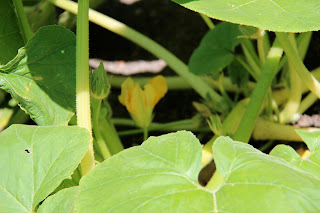This year we planted a pumpkin plant in the front garden along with grasses, a weeping caragana and a bergenia. It was planted as a small plant as soon as the threat of June frost was over and now about four weeks later it has overtaken the area and has a multitude of blossoms that will hopefully soon become pumpkins. We plan to crop extra vines in order to allow the pumpkins to grow as quickly as possible, given our short frost free season.
This garden is visited regularly by the neighbourhood bunny who likes to rest in the shade of the plants as well as on the cool shaded lawn. So far he has nibbled on the tall grass but has left the pumpkin and bergenia alone.
 |
| Lots of male flowers |
 |
| A female flower with the start of a pumpkin |
5 days later, September 12 we remeasured. Our pumpkin now measures 16 inches long and is 28.5 inches. In five days it grew 3 inches in length and 4 inches in circumference.
We are closely watching the pumpkin patch, as the littlest pumpkin (below), which used to be the largest pumpkin, began to get soggy underneath so we harvested it today (Sept. 12). It has started to change into a deeper orange colour but although it isn't quite "ripe" we removed it from the vine before further damage occurred. We will watch daily for any damage to our biggest pumpkin.





















